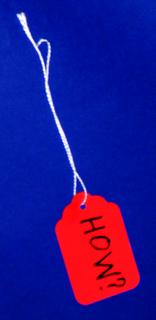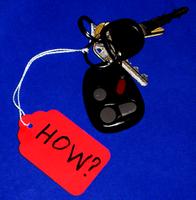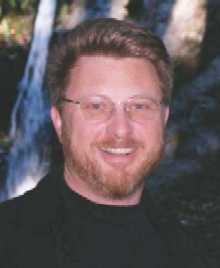 And there is no quick, easy way to change that habit. But as part of the education program at Pasadena Walks! we have developed our "Red Tag Your Car" program to help us car-addicts to at least begin to recognize the issue.
And there is no quick, easy way to change that habit. But as part of the education program at Pasadena Walks! we have developed our "Red Tag Your Car" program to help us car-addicts to at least begin to recognize the issue.Car Riding Is Unhealthy
We all understand that automobiles create air pollution. Some companies have even worked out a process by which you can assuage any guilt over fouling the air. See greenlagirl's recent rundown on Car Pollution Offset programs.
But there are other issues with cars -- many many issues with cars -- each of which could warrant its own discussion. Instead, here is a list:
- Obesity Epidemic. This is really a poor nutrition and lack of exercise problem. For a compelling data set, have a look at this shocking CDC power point or PDF. More walking instead of car riding provides extra accidental exercise.
- Community Isolation. Driving from place to place removes one from contact with neighbors and the community.
- Children Suffer. Kids who are carried in a car everywhere don't understand the spatial relationships of their own neighborhoods, or how things are interconnected.
 This lack of understanding translates into their school work, as well as creating adults who do not understand how their own community is interconnected. This is a shocking consequence of car addiction, and is well documented.
This lack of understanding translates into their school work, as well as creating adults who do not understand how their own community is interconnected. This is a shocking consequence of car addiction, and is well documented. - Noise. Internal combustion engines and autos in general make a hell of a lot of noise. Want proof? Get up super early -- anytime from say 3:00 am to 5:00 am or so -- in any major city. Listen to the silence. Now listen for the roar of the river of cars even now flowing down the freeway. How many miles away are those cars? Wow.
- Cars Reduce Property Value. Its true: High auto traffic means lower property values. Kids can't play in their yards, or think they can't. Folks don't like to walk on the street as the roar of cars flows by.
- Traffic Problems. The only way to have fewer cars on the road interfering with those times when we really, truly must drive a car is to (drum roll) put fewer cars on the road. That means you. No, building more, wider, faster roads won't fix it; in a nutshell, roads are trip-attractors. Extra capacity encourages more people to drive. More driving makes people fat and unhealthy, plus adds to problems 1-5 above.
Enough Already! I Can't Quit Using A Car.
 Let's assume, for now, that driving a car is sometimes, maybe even frequently, required. Is there anything we can do about the rest of the time? Anything easy that is?
Let's assume, for now, that driving a car is sometimes, maybe even frequently, required. Is there anything we can do about the rest of the time? Anything easy that is?
Yes there is. But it starts with recognizing that we -- that you -- have an addiction.
That's right, you. Even if you think you are pretty green already, the odds are high that you have a car addiction, and that you, like most of us, feed it constantly like the unconscious chain-smoker.
One model of addictive behavior is the unconscious, repetitive act, which may well be detrimental yet which continues unabated, cloaked in lack of awareness or ornate rationalizations.
Oh.
And really, when was the last time you went somewhere with friends, and didn't reflexively reach for the ol' car keys? When was the last time you said "Hey gang! How shall we get there?" Try it. Bet the rest of your group looks at you with a complete lack of understanding. It will never have occurred to most of them to ask. "Why," someone will say "is your car dead?"
Try it. I'll wait.
Before You Drive, THIMK.
Glad to see you're back. See what I mean?
 My grandfather had an old gag poster over his work bench that said "Before You Louse It Up, THIMK!" Hah hah. But it can work for the car addict as well. Remember, it is often the unconscious repetition of a self-destructive behavior that creates the addiction element. Pasadena Walks! uses the "Red Tag" process to help remove the lack of thought that goes into our driving habits.
My grandfather had an old gag poster over his work bench that said "Before You Louse It Up, THIMK!" Hah hah. But it can work for the car addict as well. Remember, it is often the unconscious repetition of a self-destructive behavior that creates the addiction element. Pasadena Walks! uses the "Red Tag" process to help remove the lack of thought that goes into our driving habits.
Now if you were standing here with me, I would hand you one of these cool Red Tags. If you want, you can click the one here and print the picture, but a real red tag is cooler. If you want, email me with your mailing address and I'll send the first 25 or so folks one. But they are available at an office supply store. These are from Staples, although they are not in their on li ne catalog.
ne catalog.
Anyway, start with the Red Tag, and on one side, in block letters, print the word "HOW?" On the other side, print the word "WHY? " Now, attach the tag to your keys. Hey, that's not so hard, and already you're greener!
No, really.
 See, when next you pick up your car keys, ask yourself the question "How can I get there?" Just asking the question is a big
See, when next you pick up your car keys, ask yourself the question "How can I get there?" Just asking the question is a big
step. Make it explicit, though, ask out loud. If you are alone the foolishness of talking to yourself may cause a longer pause for reflection. If you are with folks, they will assume that you are asking them (and you are, really).
Walk, Bike, Ride
Could we walk to where we are going? Ride a bike? Take a shuttle or light rail or commuter rail or even (shudder) a big urban bus? The answer will usually be "Yes, but . . . ."
It's the "but" that is killing us. "Yes, but it is too far." "Yes, but I don't have time to bike." "Yes, but my clothes will get messed up." "Yes, but I don't feel safe." Which brings us to the next question and the other side of the tag: "Why?"
Why do you have to ride a car, you should ask yourself, and your friends. This gets  the "Yes, but" out in the open. We acknowledge that we have "reasons." Good reasons. Really good reasons -- until we thoughtfully and carefully examine them.
the "Yes, but" out in the open. We acknowledge that we have "reasons." Good reasons. Really good reasons -- until we thoughtfully and carefully examine them.
COMING UP NEXT:
Your Excuse Isn't Really As Ironclad As You Thought or
Getting to "Well, Ok, Maybe. But . . ."

6 comments:
Eagerly awaiting to find out how good my excuses are ;)
I think that -- especially with the greater LA area being so spread out and difficult to navigate via public transport, the best bet is to try and find alternative means for trips you make REGULARLY first. Ya know -- since it takes some work figuring out bus routes or bike paths to get anywhere. This way, you can do the research once, then use the method over and over again :)
Rofl! Once again, you are so past this stage.
Two Hints from Part II:
1. Bike Paths are everywhere. We call them roads. The bigger issue is having a bike ready to ride, and deciding to do it when possible.
2. Short trips such as local errands can become pleasant walks and easy bike rides, and for the *truly* car-addicted in denial these can be easy "baby steps" to recovery.
Stay tuned!
I disagree that bike paths and roads are synonymous. Having (1) been in a minor bike accident on a major road in the US that could have been much worse and (2) lived in the Netherlands for four months with dedicated bike paths, I'd say that the two terms *could* be synonymous but are not so yet.
I'm not real steady on a bike. Even tho I learned when I was fairly young, I haven't had a lot of practice. Therefore, to start out, I'm not comfortable riding on a street with a lot of car traffic, especially if I don't have a designated lane. So far, most of my non-car using has been a result of taking the bus or walking, even tho I'd like to incorporate more bike use into my regimen.
Second, my dad and I were even talking about the community issue today. I made a flip remark that I almost hoped they didn't find a cheap alternative energy source, b/c that would just put more ppl back on the road. No matter how available or renewable energy is, it won't solve the gridlock problem, so mass transit really is the way to go.
Today, in my kick the car attempts, I took the bus to work (football stadium in Seattle). However, I did drive to the park and ride first. Still, it was nice, I avoided a ton of traffic, and I even saved money since I didn't have to pay to park.
Tomorrow, I'll be walking to the library and grocery store (both within the mile). Have to use the car to go to the employer's house, since I don't know her address . . . but I intend to find out so I can see if I really can take the bus there.
Baby steps, right?
Baby steps, yes! The value of a bike is that it extends the range with no real extension of additional effort.
As for roads v. bike paths, the short answer is that you're right, roads are different, both legally and in what can be done on them. My rhetorical point, which I attempted in five words or less, was that special bike paths were not at all needed to make good use of bike driving as an alternative to the all-auto culture.
In California bikes are vehicles, and entitled to use the road lanes. In Pasadena we have gone an extra step and keep our speed limits low (30 or less)and have hundreds of "Share the Road" signs up.
A bike lane can be provided, but it has limitations and legal restrictions that may not make it the best choice for a given road.
Most bike accidents occur when cars strike cyclists who are either (1) riding the wrong way and thus come into collision course unexpectedly, or (2) riding on the sidewalk and get hit at intersections during car turning movements.
You can take courses offered by various local instructors (often free) on "Vehicular Cycling" to make yourself quite safe in city traffic.
Having said that, a great deal depends on your local laws and the attitude of law enforcement toward non-auto travel. Many police officers here still don't realize that a bike is a vehicle under state law, and treat it like a toy that does not belong on the road.
Some links for you:
www.bikesbelong.org (An industry group, though, so grain of salt, etc.)
Vehicular Cycling Basics (One of Many)
http://www.bicyclinglife.com/PracticalCycling/VCIntro.htm
Thanks for the thoughts!
Hey, love the blog (just found it via Treehugger). I like the approach. Keep it up. (Check out my blog sometime if you have a moment). Cheers...
Post a Comment